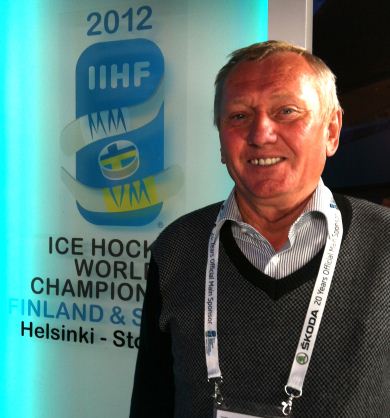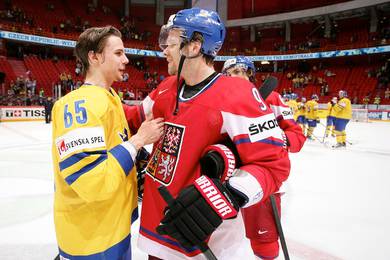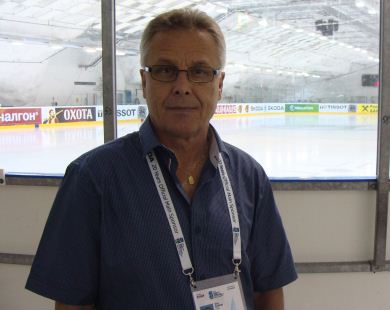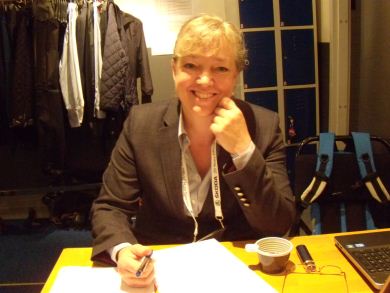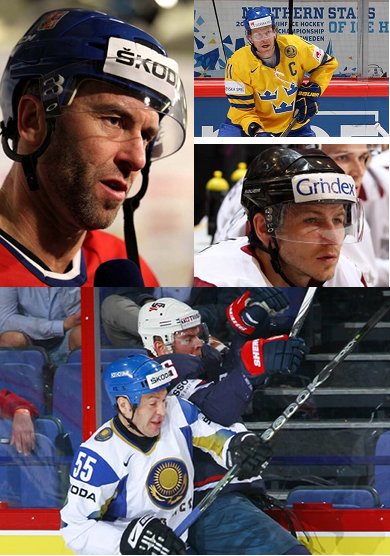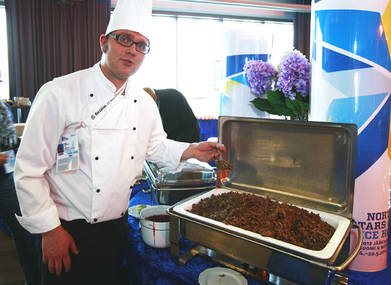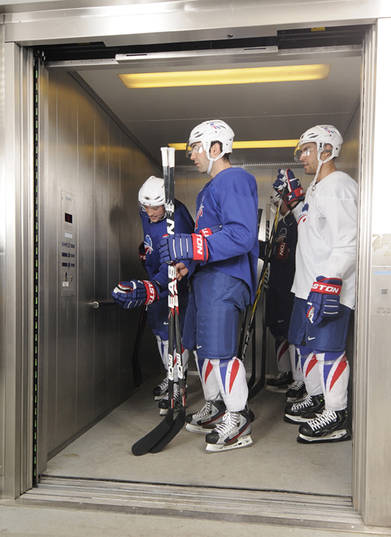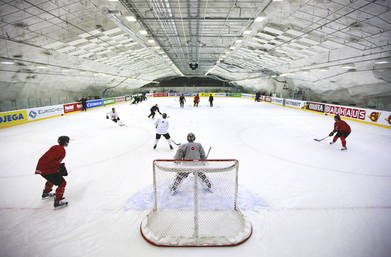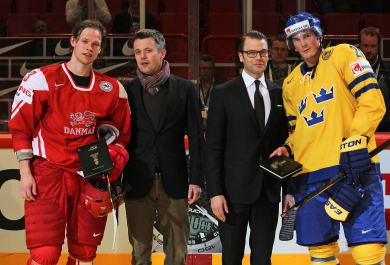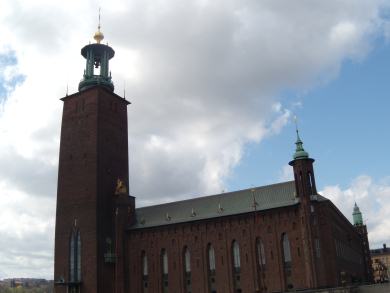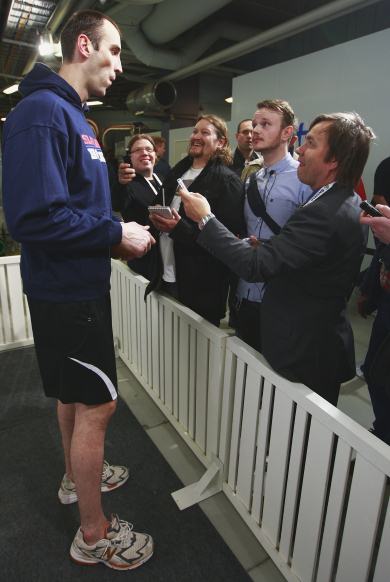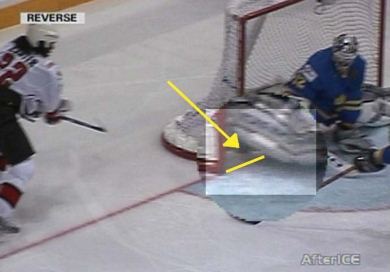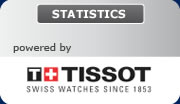Welcome to the IIHF Worlds 2012 blog. Throughout the championship you will be able to read about our impressions behind the ice in Helsinki and Stockholm.
Risto Pakarinen / 20 May / Helsinki
Miroslav Satan has proved that he’s still a worldclass player, scoring two in Slovakia’s semi-final win over the Czech Republic. Having already secured a medal in Helsinki, Miroslav Satan is now the only Slovak player with four World Championship medals.
But if his father had had his way, Miro would have become a soccer player instead.
“I used to play soccer, and I wanted my sons to play, but during the winters hockey just took over, and then one year, a coach asked me to join him, so I coached Miro and his friends from when they were in third grade until they were 17 years old,” says Emil Satan, Miroslav’s father, who has once again traveled to the World Championship to see his son, and Slovakia play.
“He always comes to the Worlds, especially for the end, hopefully he brings us good luck,” Miroslav said.
Emil Satan is a big personality who greets people, shakes hands, always with a big smile on his face, as he works his way through the crowd at the Hartwall Areena, just as he does when he’s watching Miro’s games with Slovan Bratislava back home. He says he saw almost every game this season.
“I haven’t been to all of Miro’s twelve tournaments, but I have been to six of them, so half. I’d probably try to come even if he didn’t play, but not as much,” he says.
One of the tournaments he witnessed first hand was the 2002 World Championship in Gothenburg, Sweden, which Slovakia won. But for a father, almost as big of a memory is the one-page story Finnish newspaper Länsi-Savo wrote about Miroslav when his youth team played in a tournament in Mikkeli, Finland.
What does he think about Miroslav’s game now?
“Well, he’s not as fast as he used to be, but he compensates that with his hockey smarts and strong will, which we saw in the game against the Czechs,” he says.
Now that Miroslav, the oldest of Emil’s three sons, is about to make Slovak hockey history, is Emil disappointed with the fact that he didn’t become a soccer player?
“No,” he says, smiling.
“But I do think that had he chosen soccer, he would have become a good international player,” he adds.
Now, though, he has a World Championship final to win.
“If Slovakia is tied with Russia after two periods, they’ll win,” says Emil Satan.
Lucas Aykroyd / 20 May / Helsinki
Nowadays at the IIHF World Championship, you often get reminders of just how small the hockey world has become. There was one on Thursday night in Stockholm.
But first, to put things in perspective, imagine it’s 1972. At the Worlds, a player from Sweden and a player from Czechoslovakia might have a nodding acquaintance at best. They wouldn’t be NHL teammates. They wouldn’t exchange emails. Going out to dinner together would be a perilous exercise due to the Iron Curtain divide between the West and Communism back then.
However, our world has changed so much: politically, economically, technologically, and sports-wise. As a consequence, in 2012, there are connections between people on virtually all 16 teams that take part in the World Championship.
At this year’s tournament, two Ottawa Senators teammates, Sweden’s Erik Karlsson and the Czech Republic’s Milan Michalek, chose to represent their countries after their NHL club was eliminated in a seven-game, first-round thriller against the New York Rangers.
Michalek, of course, made a great play to score the 4-3 winning goal on host Sweden in the quarter-finals with 29 seconds left.
Afterwards, during the handshake lineup, Karlsson was overheard asking Michalek in a rueful, tongue-in-cheek way: “You couldn’t do that against the Rangers?”
In tonight’s final, KHL teammates going head to head for gold include CSKA Moscow's Sergei Shirokov (Russia) and Tomas Surovy (Slovakia), Atlant Mytishi’s Konstantin Barulin (Russia) and Branko Radivojevic (Slovakia), and Yugra Khanty-Mansisk’s Mikhail Biryukov (Russia) and Tomas Starosta (Slovakia).
Martin Merk / 19 May / Helsinki
The team guide is the liaison person between the organizer and the team. He takes care about the logistics, timing and that everything works smoothly for the athletes in the foreign environment.
How many national teams get a team guide who speaks both the local and the team’s language? Many, as it’s an important part of the job.
How many teams get a team guide who was a coach at the top European level? Not many. How many teams get a team guide who’s an author? Even fewer.
And only one team has a team guide who’s all that. Switzerland’s team guide was Esa Sirén, who spent many years of his coaching career in Switzerland, Austria, and Southern Tyrol, a predominantly German-speaking area in Italy, and speaks German fluently.
He calls Switzerland his second home having lived there for 12 years. His son, Niki, still played in the Swiss National League A this season.
In Finland, Esa Sirén played for HJK Helsinki in the top league and for his hometown team Kouvola KooKoo one tier below. Among his coaching stints was SaiPa Lappeenranta in the Finnish top league and he was also an assistant coach of the Finnish U20 national team.
But his highlight years as a coach were in the Alpine country.
“My highlight was in 1987/88 when Rapperswil was promoted and we were suddenly second,” Sirén said. “But also that I could help develop players at the Grasshoppers who made the national team or even played in the NHL, like Thomas Ziegler.”
For Sirén, volunteering as a team guide is nothing new. It’s the fifth time he has done it when Finland hosted the event, after 1982, 1991, 1997 and 2003. “I like it, otherwise I wouldn’t have done it for the fifth time,” he said.
“I was the team guide for Switzerland three times, one time for Austria and one time for Italy,” the Finn said. “The Finnish Ice Hockey Association gave me an education once, and it helped me a lot, not only in Finland, but also in Switzerland, and Austria, and Italy. Working as a volunteer is my way of paying back.”
Apart from the short temporary stint with Swiss third-tier team Pikes Oberthurgau, the 64-year-old uses his retirement to write books. Inspired by the tales of his father, he has written eight books about Finland's wars with Russia that took place a few years before he was born.
“They're all war novels,” he said. “They were originally published in Finnish, but now I signed a contract with a publisher to sell the books also in English and German.”
Asked about his best book, he mentions “Ilomantsin ritaripartio” (Knights of Ilomantsi) of which more than 10,000 copies were sold. A good number in a country of a little more than five million inhabitants.
“It’s a story about a Finnish partisan group who should attack a Russian weapon transport. Stories about partisans, or ‘sissi’ as we call them here, are very popular,” Sirén said.
“The idea came from my father who served in the war and I started to read what the veterans wrote as a young guy,” he said. “I find much information from stories from veterans and from the internet. I’d rather write books than play golf.”
With the tournament advancing to the semi-finals and Switzerland having travelled home, he can now focus on his next book projects.
Lucas Aykroyd / 15 May / Stockholm
If you thought you heard a woman’s voice on the public address system during IIHF World Championship games at Stockholm’s Globe Arena, you weren’t mistaken. Lotta Johansson-Bräck, who has handled these duties since 2008 for Djurgården, one of Stockholm’s elite hockey clubs, is also on the mike at this tournament. Even though few women have entered this profession, she is happy to be winning over skeptics and breaking down the gender barrier.
“I started off as a figure skating announcer, because my daughter was competing in figure skating,” Lotta told IIHF.com in an interview at the Sport Office on Tuesday morning. “They needed someone, and I said: ‘I can do it.’ Then all three of my sons started playing ice hockey, and again they needed someone. So I said: ‘OK!’”
She spent a year doing statistics with Djurgården before being asked to do the P.A. “It’s rather unusual,” Lotta admitted. “But I feel like I’m [blazing a trail], because now we have many more women getting involved.” For instance, Berit Gibbs does the same job with Djurgarden’s traditional cross-town rival, AIK, while Ann-Catrine Johansson is the speaker for Luleå Hockey.
“I think it’s just a Swedish phenomenon,” said Lotta. “I haven’t heard about it in other countries. I think it helps that Sweden is good at women’s hockey as well. This is becoming more of a mixed sport.”
And are there plusses for the audience in terms of having a female P.A. announcer?
“I think as a speaker, it’s an advantage to have the kind of voices we have. When it’s very crowded, it’s easier to hear our voices than a guy’s voice. We’re higher, and that’s probably why it gets through.”
Certain names are more challenging to pronounce than others at a tournament like the IIHF World Championship. For Lotta, the Latvians and the Czechs require the most practice with phonetic guides.
“You have to pronounce things in English and in Swedish, and of course these are foreign names. From time to time, you get things mixed up when you’re reading a long text and you end up with ‘Swe-english.’ I’m trying to keep them apart.”
She’s announced at games on the Euro Hockey Tour, but this is her first time at an IIHF World Championship. She’s not taking anything for granted.
Hockey is a passion for her – she’s relished the opportunity to meet her favourite players from Börje Salming to Jimmie Ölvestad, whom she describes as “Mr. Djurgården.” Even though Djurgården has been sent down to the Allsvenskan for 2012-13, she hasn’t lost her excitement.
“I am so privileged,” she said. “I love being at all the matches. I have seen so many great matches. On the other hand, I see them a bit of a different way than you would sitting in the stands. I’m following all the judges, and sometimes people ask me: ‘Oh, you saw the game – how was it?’ And frankly, I don’t know! I’m so focused on getting everything right. You have to know what you’re doing.”
Lotta is hoping to keep her place behind the mike for a long time to come.
“It’s an honour to be a speaker,” she said with a smile. “As long as they ask me, it’s great.”
Risto Pakarinen / 14 May / Helsinki
Every time I interview the players in the mixed zone, I am reminded of how big the boys are. They, even Zdeno Chara, look tiny from the pressbox, especially since our seats are almost as high as you can get in the Hartwall Areena. I am easily fooled, I suppose.
And then I go to ice level, and see how fast today’s game is, and I shake my head at the thought of people playing hockey helmetless just a couple of decades ago. (Craig MacTavish, the last player to play in the NHL without a helmet, retired in 1997).
These days, I even consider it strange to see players play without a visor - even if I do remember how cool it felt to toss away the helmet when we fooled around after practice, or played pickup hockey wearing a tiny Gretzky-style Jofa.
I guess I’ve got old…er.
In fact, truth be told, if I played in this World Championship, I would wear a visor, even if, according to the rules, I would have the right to choose whether to wear one or not, because, rule 224 b states that “male players born after December 31, 1974 shall wear, as a minimum, a visor.”
There are six players born before Dec. 31, 1974 playing in this tournament.
Petr Nedved, Czech Republic, Dec 9, 1971
Fabrice Lhenry, France, Jun 29, 1972
Daniel Alfredsson, Sweden, Dec 11, 1972
Alexei Troshinski, Kazakhstan, Oct 9, 1973
Andrei Mezin, Belarus, Jul 8, 1974
Rodrigo Lavins, Latvia, Aug 3, 1974
Two of them, Lhenry and Mezin, are goalies so wearing a visor is not even an issue for them. Of the remaining four, Nedved, Alfredsson, and Lavins have opted to wear a visor, which leaves us with one last remaining visorless player in the tournament: Kazakhstan’s defenceman number 55, Alexei Troshinski.
The Vityaz Chekhov player has averaged over 17 minutes a game here, and has battled hard, so he’s obviously not ready to become the answer to just another trivia question: "Who was the last player to play in a World Championship without a visor?"
Not yet.
Andrew Podnieks / 14 May / Helsinki
I know I swim in murky waters here because one culture’s passion is another’s poison. Still, there is one adjustment I can’t seem to make here in Helsinki. The IIHF has hired a local company to provide food in the hospitality area, but every third day the dinner option features one item prominently – reindeer.
Sorry, but I just can’t stomach the thought of eating Santa’s helpers. I grew up singing “Rudolph the Red-Nosed Reindeer”, but the thought of these cute little creatures delivering presents to kids throughout the world on December 24 and then getting slaughtered for their troubles is an image I just can’t shake.
My Finnish colleague Risto assures me I am no weirdo. He says he’s had reindeer about three times in the last 20 years and that by no means is this an average, everyday meal for Finns. But it’s funny how one image can cloud an opinion. I’m not much of a fan of rabbit either, again probably because I remember the big bunnies who’d hand out chocolate eggs in malls at Easter time. Hamburgers I have no problem with because the image of a cow in a field is agricultural enough that eating the immobile fella seems okay. Ditto for ribs, steak, and most other farmland-type meat.
I am no wuss, though. I did try the reindeer, but I thought it was dry and sort of tasteless without the cranberry sauce. But even if I had liked it, I don’t think I could have tucked in to a full plate. Reindeer is for Christmas Eve, Christmas song, and Christmas spirit. To me, anyway.
Leena Huhtamaa / 12 May / Helsinki
Note: this entry is part of the Event News section and is also available in Finnish and Swedish.
The 2012 IIHF Ice Hockey World Championship’s tournament look has conquered the Hartwall Arena. The Finnish organizers invite us to a little tour to the stars.

"The Northern Stars of Ice Hockey" constellation can easily be found at the arena as well as the surrounding area.
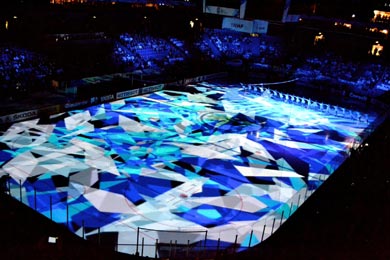
On the opening day, the Northern Stars were transferred on the ice, when Mikki Kunttu’s light installation was reflected in the ice surface. A little hint if you have missed it: there’s a light show before every game.
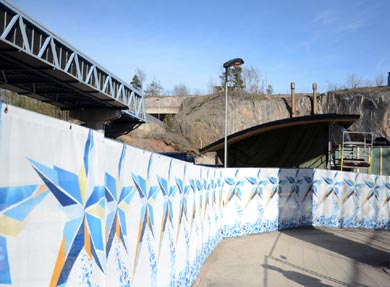
If you get to the venue by train to the Pasila station, you will find your way easily by following the stars. When you finally get to the Hockey Garden Fan Zone, you will see the sea of white tents, flags, and Northern Stars.
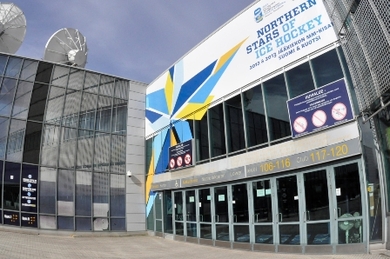
The Stars are surrounding the entrances. If you look closely, you might see the official game mascot, the Hockey Bird, taking a peak here and there.
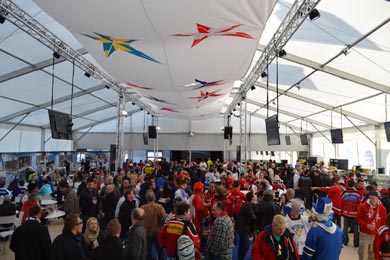
The elements of the game brand are seen at the partner areas in many ways. For example, the ceiling of the restaurant called Hall of Fame has stars that are designed in the colours of the participating teams.
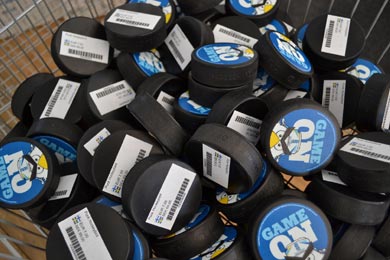
Fan products like “the Game On” pucks have cheerful Hockey Birds on them.
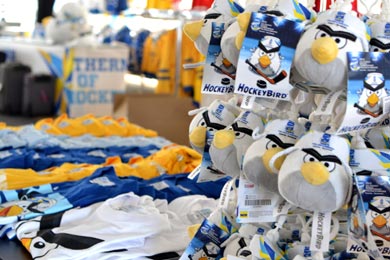
Different sizes and shapes of Hockey Bird mascots will find their ways to children backpacks and beds.
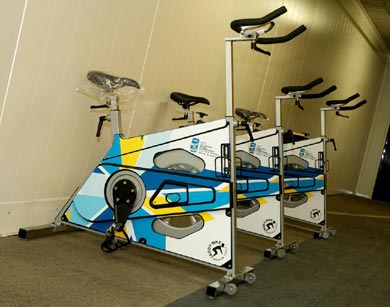
Even the hockey players won’t miss the look and feel as they warm up on bikes before the games.
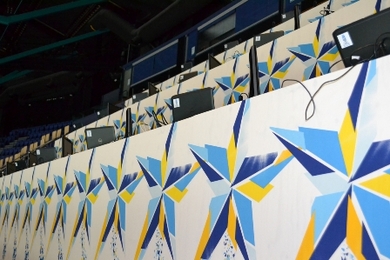
And even the press and commentators area stands out at the arena.
Martin Merk / 10 May / Helsinki
At the Hartwall Arena in Helsinki, and at the Ericsson Globe in Stockholm, teams are in the lucky situation that a second ice sheet is basically a stone’s throw away from the main arena, facilitating logistics for practices.
In Helsinki, however, the second rink is not beside the main one, but far underneath, built in stone.
While the media has to walk down a long tunnel – or be driven in golf cart – players go down from the other side of the ice where they have an elevator which brings them to the rink 37 metres underground and lifts them up again to the dressing-room area.
The setup can create some unusual pictures, like the one below with French players trying to find the button, which poses an extra challenge when wearing hockey gloves.
Whether France’s journey in Helsinki will bring them up or down in the world rankings will be known in less than a week. The victory against newly-promoted Kazakhstan at least gives them some hope of staying up in the top division.
Andrew Podnieks / 9 May / Helsinki
“The Rock” can mean many things to many people. In Canada, it’s a friendly term for St. John’s, Newfoundland. For Hollywood, it refers to Dwayne “the Rock” Johnson, the wrestler-cum-actor (or something). There’s the Rock of Gibraltar and there’s a solid defenceman (“he’s a rock back there”) and to any woman of material ambitions the most important part of marriage is getting a “nice rock” for her finger. There’s rock ‘n’ roll and rock-a-bye baby and various other uses of the word.
The practice arena in Helsinki is part of Hartwall Arena. Sort of. That is, it’s all part of the same building. Sort of. In other words, you can go from the main arena to the secondary one without having to go outside. Sort of.
The practice rink is, in fact, two stories underground. It is carved out of a rock, and it is not easy to find. You can enter through a single door on the outside, carved out of this small urban mountain range, or you can walk to the back end of the main arena and wend your way downstairs circuitously from there.
As you descend, past the stick-painting area (another curious feature of the World Championship), to get to the rink, you smell the cold, musty rock, and when you get to the rink itself, you are surrounded by rock painted white to give the area that hockey feeling.
The ceiling is as low as you can possibly imagine for a hockey rink. It feels as though Shaq could jump up and touch the lights, but perhaps it’s a bit higher than that. The Plexiglas is pock-marked with puck marks like a Gerry Cheevers mask. Yet even down here, there is the Skoda logo at centre ice and ads along all of the boards. Sponsorship knows no depths to which it cannot plunge.
The cold shoots through your bones, and you feel like you’re in a big cave. You can imagine Neanderthal man finding a place like this and playing hockey with a few T Rex fibulas for sticks and guano for a puck.
I was there when teams weren’t practising, so it was also darker than usual, but it had a subterranean charm that is such a contrast to the above-ground modernism of Hartwall itself. They are so different they can’t possibly be connected – but they are. Sort of.
Risto Pakarinen / 8 May / Helsinki
I don't know for sure what goes through Mikhail Grabovski's mind when he scores for Belarus, besides general feelings of happiness and pride, but I wouldn't be surprised if a part of the mental images his brain produces are of a Belarusian man, named Yas, let's say, out on the field mowing clover, dreaming about Yanina, a hardworking girl!
That's what I will be thinking about, anyway, now that I've learned what the Belarusian goal song, "Касіў Ясь канюшыну" (Kasiu Yas kanyushynu) is all about. Now, I would have known that earlier had I understood the title of the song, which is, in short: Yas mows clover.
Before the tournament, the organizers asked all teams to send in their goals songs, if they had any particular wishes. Most did that, some had a song chosen for them. But why do teams pick certain songs? Here are my guesses.
Belarus: Kasiu Yas kanyushynu
All songs by the prolific composer “Trad” are popular at hockey arenas, and Belarus is no exception. And the message is powerful. It keeps players grounded, and emphasizes the importance of team effort.
Canada: Blur - Song 2
Woohoooo! Wooohoooo! I’m fairly sure the song also says something about a Zamboni. If I’m hearing it right, they sing, “I got a hip check / buy a Zamboni”. Can it get any more Canadian than that?
Finland: Teräsbetoni - Taivas lyö tulta
Well, if Finland is famous for anything besides great hockey, it’s engineering (and Angry Birds). And what’s the one thing that you need for advanced engineering? That’s right, reinforced concrete, which is what the name of the band means. Besides, four shirtless dudes in too tight pants yelling at the top of their lungs? That’s called "Thursday night" in Finland.
France: Zombie nation 3000 - Kernkraft
No, no, the name of the DJ is not a comment on the team. Say whatever you want about the French defence, but Baptiste Amar & Co are no zombies. While Finns go for the reinforced heavy metal bands, France likes to keep things a little lighter. When they score, they celebrate it like they were in la discothèque. Oui, oui.
Kazakhstan: Kiss - Heaven’s on fire
KAZ and Kiss just go together so well. You hear Kiss, you think of KAZ. Kiss, KAZ, Kiss, KAZ. Straightforward. Also, the lead singer of Kiss is Paul Stanley so there's a hockey connection. Stanley Cup, anyone?
Slovakia: Nech Bože dá
This is the official Slovak hockey song so it was an obvious choice for them. There are three verses, one for each period, obviously. I smile every time I hear the line, “Someone roars, Milan scores!’” (Or something along those lines, I AM relying on Google Translate here).
Switzerland: Avicii - Levels
What do you get when you score a goal? A good feeling, that’s what. And that’s 100% guaranteed what you’ll be humming to yourself for days after Switzerland scores. Which is why Avicii’s song is their goal song. (Also to lull the opponent into thinking that they, too, have a good feeling).
USA: The Fratellis - Chelsea Dagger
Ba-da-da-dum, ba-da-dum, ba-da-da-da-dum, ba-da-da-dum, ba-da-dum, ba-da-da-da-dum, ba-da-da-dum, ba-da-dum, ba-da-da-da-dum, ba-da-da-dum, ba-da-dum, ba-da-da-da-dum, ba-da-da-dum, ba-da-dum, ba-da-da-da-dum, ba-da-da-dum, ba-da-dum, ba-da-da-da-dum. If it’s good enough to be the goal song for Glasgow’s Celtic Football Club, Edinburgh’s Hibernian Club, a few football clubs in Belgium and Australia, the Baltimore Orioles, the Tampa Bay Rays, the Chicago Blackhawks, and the Washington Capitals, it’s good enough for Team USA. (And if Mats Sundin was humming that after his last NHL game, knowing he’d retire right afterwards, you know it’s a powerful tune).
Everybody’s got a tune here. The Hockey Bird, obviously, has DJ Slow’s “Hockey Bird (In The Zone)”, but there’s a theme song even for the Zamboni, “Ice machine” by the Laughing sausages.
It makes me want to have a theme song of my own. Any suggestions?
Lucas Aykroyd / 8 May / Stockholm
Hockey fans with an appetite for royalty and celebrity got a double dose at the Denmark-Sweden game on Monday night at the Globen Arena.
Not only did Crown Prince Frederik of Denmark and Prince Daniel of Sweden attend the 6-4 Swedish victory, but they also presented the post-game Player of the Game awards.
A pair of Dallas Stars teammates got a little bit starry-eyed as they were honoured. It was defenceman Philip Larsen (one assist) getting the royal treatment for Denmark, and left wing Loui Eriksson (two goals, one assist) enjoying the same for Sweden.
For both princes, support for sports is not mere lip service.
Crown Prince Frederik has been a member of the International Olympic Committee since 2009, and has participated in everything from marathons to competitive sailing.
Prince Daniel, prior to his 2010 marriage to Crown Princess Victoria of Sweden, worked as a personal trainer and operated a chain of gyms in Stockholm. His passion for hockey led him to stage a reception at the Royal Palace for the Swedish U20 team that won the nation’s first World Junior title since 1981 back in January.
While medieval times witnessed plenty of conflict between the Kingdom of Sweden and the Kingdom of Denmark, this latest joint appearance by the princes is far more representative of the cordial, friendly tone between the two Scandinavian neighbors nowadays.
Seemingly, it’s a good time overall for royalty in hockey. Even in North America, where one of the NHL’s Western Conference finalists is the Los Angeles Kings.
Lucas Aykroyd / 7 May / Stockholm
When visiting Sweden, it would be a major faux pas to not acknowledge the country’s most famous musical and cultural export: ABBA.
We at IIHF.com certainly wouldn’t want to be guilty of such a transgression. So we hooked up with the ABBA City Walk, a two-hour tour of downtown Stockholm with ABBA-related sights that is organized by the Stockholm City Museum. Wearing platform shoes is not recommended since it’s a walking tour; the skintight white jumpsuit is optional.
(If you’re wondering, “Does ABBA have anything to do with the IIHF World Championship?”, the answer is yes. For the 1981 tournament held in Gothenburg, the group’s Benny Andersson penned “Fanfare of the Ice Hockey World Championship ‘81”, a half-minute synthesizer track that was played at the games.)
The tour departed from the brick-walled Stockholm City Hall, which enjoys a waterfront location on Kungsholmen Island downtown. With guide Mia Freitag sporting a portable stereo that blasted out favourites like “Mamma Mia” and “Money, Money, Money,” we learned about how a scene for Lasse Hallstrom’s ABBA: The Movie was filmed in the penthouse of the 1971-built Sheraton Hotel, how the best-selling pop group of the 1970s performed at the Royal Opera House for Queen Silvia and King Gustav XVI the day before the royal wedding, and so on. It all came to life while viewing the actual locations in central Stockholm.
Demographically, the tour seemed to appeal most to women from Belgium, Norway, and England who could recall ABBA’s 1974 Eurovision triumph with “Waterloo”. However, given ABBA’s continuing enormous popularity today, it could be fun for people of all ages and backgrounds.
Certainly, the influence of ABBA is apparent in the bouncy pop ditties that have been written for other World Championships in Sweden. “Nu Tar Vi Dom” (1989) and “Den Glider In” (1995) are still rocking the Globen Arena during games this year.
Andrew Podnieks / 7 May / Helsinki
In addition to hosting the World Championship this year, the Hartwall Arena is host to an annual event called the Karjala Tournament. Named after its eponymous beer sponsor, the event started in 1996 and features four teams in a round-robin event each November.
The 2011 Karjala Tournament was won by Russia with a lineup that included Alexander “sorry I’m late” Radulov as well as several other well-known players – Igor Grigorenko, Ivan Vishnevski and Alexei Tereshenko.
Incredibly, Finland’s lineup featured no fewer than 12 players here in town for the Worlds, notably goalie Karri Rämö, defencemen Ossi Väänänen and Lasse Kukkonen, and forwards Mika Pyörälä and Mikael Granlund (not to mention legendary 38-year-old Ville Peltonen).
Sweden and the Czech Republic rounded out the event which sees usually all games played at Hartwall plus one in another team’s country (often Sweden or the Czech Republic). Finland has won the event ten of 16 years, most recently 2010. Russia has won every other year recently going back to 2006. The Swedes won once, in 1997, and the Czechs have never won, but the event is a great opportunity for players to gain international experience against world-class competition in anticipation of the World Championship.
Risto Pakarinen / 6 May / Helsinki
Let’s start with a fact. I am officially 170 centimetres tall. That’s below average in most Western countries, the average in Brazil, and above the average in countries like Bahrain, Chile, and Gambia. In Indonesia, where the average height for males is 1.58, I would be considered tall. None of them big hockey nations, though.
There are 400 players in the 2012 IIHF Ice Hockey World Championship, and most of them are at least 180 cm tall. In fact, 180 is considered almost small these days. Canada, for example, doesn’t have any players shorter than that and only one, Jeff Skinner, who’s exactly 180 cm. On the other hand, Canada has seven players that are over 190 cm.
But among all the big boys, there has to be one who’s just the tallest, and that’s Slovakia’s Zdeno Chara who’s 205 centimetres in his socks, and 215 cm with his skates on. Even if I raise my arm straight up, and stand on my tiptoes, I could only reach the top of Chara’s head when he’s wearing sneakers, but not the top of his helmet when he’s fresh off the ice, with skates on.
Fortunately for me, his mouth is not that high up, so I can get my tape recorder in position when I interview him. Also, he likes to go to the dressing room and change before meeting the media, which makes it a little easier.
I’m trying to convince a colleague of mine to do the old “long-coat-over-two-guys-with-one-sitting-on-the-other’s-shoulders” trick the next time we interview Zdeno, who, and this can’t be stressed enough, is a very nice man, a good sport, and a great hockey player.
Maybe one day I get to interview Italy’s Vincent Rocco who’s 166 centimetres tall. I won’t be wearing my Timberlands for that.
Lucas Aykroyd / 5 May / Stockholm
Unfortunately, due to privacy concerns, I can't tell you where I'm staying while writing about the 2012 IIHF Ice Hockey World Championship. But the location and amenities are great, and if all the people posting on TripAdvisor.com were European hockey fans, this place would surely top the list.
How so?
This morning, I went to the hotel gym and (by coincidence) worked out with Vladislav Tretiak. Just me and the greatest goalie in Russian hockey history, selected to the IIHF's Centennial All-Star Team in 2008. This was very cool.
Naturally, I was hoping he'd bust out some of the moves – catching tennis balls, doing the splits – he demonstrates in the 1970s "Soviet Hockey Training Video" you can see on YouTube. But even seeing him on the stationary bike while I ran on the treadmill was a rush.
Then, I went to breakfast. The whole Russian team was in there, getting the fuel they need for a successful tournament. NHL scoring champ Yevgeni Malkin wandered through the dining room, munching on a piece of fruit. (Just for the record, no one greeted him in the colourful fashion that Pascal Dupuis employed in the 2010 version of HBO 24/7. As far as I could tell, anyway – my Russian's a little rusty.)
Even if you're a fan of less powerful hockey countries, there are sightings aplenty at this hotel.
The day before, Danish NHLers Jannik Hansen and Lars Eller were dining at the table next to mine. Afterwards, I got in an elevator and was joined by Latvian defenceman Rodrigo Lavins. I love the IIHF World Championship, and have covered it each year since 2000. But Lavins puts me to shame – the 37-year-old member of Dynamo Riga has been proudly suiting up for his native country since 1993, when he made his debut in the old C Pool.
To top it all off, when I left the hotel this morning, I was accosted by a pair of autograph-seeking middle-aged gentlemen, who rushed up to me with notepads extended. I just smiled and shook my head, but looking back, I really should have signed "Pavel Datsyuk" or something similarly plausible. You only live once.
Compared to, say, football, hockey is a small world. And keeping track of all the characters in our favourite sport is part of what makes it so much fun.
Andrew Podnieks / 5 May / Helsinki
The Finnish language is not for the faint of heart. Nor is it for the faker. You either know it or you don’t. I think I can figure out a few words in most Latin-based languages, but Finnish? Forget it. A quick walk around Hartwall is testament to my ignorance.
Outside the building a sign proclaimed, “Hartwall Areena”. That made me feel good. So the Finns add an extra “e” to the word “arena”. Big deal. This isn’t so difficult after all, right? Wrong.
Want to know the layout of the arena and where things are? There’s a nice map inside the front door which shows you everything – if you can speak Finnish. For instance, there’s “aitiot” which is the loge. Or there’s the red star with the words “olet tassa” which means “you are here”.
That’s only the beginning of my alphabetical misadventures. There’s the “ylakatsomji” which refers to the “upper level” and the “yleisotilat” which is “public areas”. The mother of all messes is the “ruoka-jajuomamyyntipisteet” which is where you get “food and drink”. LOL.
Most discouraging is the word “lipunmyyati” which is “tickets”. This is a word so easy to understand in many languages. The French “billets” is a clue to anything that looks like biglietti, bigliatelle, biglia-whatever. Tickets. No problem. Lipunmyyati? Puh-lease.
Even a sign that reads “alkohliton alue” is tricky. It means “no alcohol” which is easy because of the first word but “alue” gives no clue to me and you who don’t speak this lingua confusata.
The Finns loves their double-y’s and they love their umlauts (two dots over certain letters to create a new letter and new sound). They also play favourites with the letters t, l, i, and a. Indeed, they love doubles and repeated letters way more than is healthy to the non-Finn. Consider this snack called “Kariniemen kotitilalta”. This means something like, “This comes from Kariniemen’s farm”.
My favourite sign is in Finnish only: “tupakointi ulkona, portaiden alapaassa”. This means “smoking outside at the bottom of the stairs”. I get “outside” because of the “portaiden” part, but the rest is, well, Greek to me.
By the way, the only way I know what I know comes from Risto Pakarinen, my Finnish colleague who speaks flawless Swedish and English in addition to the language of double-y’s. Grazie, Risto!
It is law in many parts of the country to have signs in Finnish and Swedish, but many places also include English. Learning a few words in another language is always fun, but beyond “kippis” (“cheers”), the Finnish tongue sucks the life out of my confidence. Truly, the best Finnish words I know are Kurri, Koivu, and Selänne, three pretty good words, if I do say so myself.
Andrew Podnieks / 4 May / Helsinki
I remember it like it was nine years ago. The last time I was in Helsinki was the last time I was in Hartwall Arena, and we all remember what happened then. Anson Carter. The goal. Video review. Ring a bell?
Canada and Sweden played for gold at the 2003 IIHF World Championship, but both teams had perilously close calls in the quarter-finals. Canada and the heavy underdog Germans went to overtime before Eric Brewer scored early in the fourth period to give Canada the win.
The Swedes were trailing 5-1 to host Finland before mounting a remarkable comeback (was it a comeback – or did Finland blow it? Perspective is all.) to win, 6-5. Both winners had easy times of it in the semi-finals, setting up another Canada-Sweden clash in the final game.
Canada trailed 2-0 early in the game thanks to goals from Mathias Tjärnqvist and P-J Axelsson. Kyle Calder scored quickly after to make it 2-1, but it wasn’t until midway through the third that Canada tied it up on a Shane Doan goal. That set the stage for the OT.
This game was the first in which an IIHF game was to have a 20-minute overtime period. As well, it was played 4-on-4, and from that day to this, no such game has ever gone the distance.
Carter got the golden goal by coming around the back of the net and stuffing it in the short side before goalie Mikael Tellqvist could squeeze his skate tight against the post. But the drama wasn’t over with the goal – it was only just beginning.
Carter whooped and screamed in celebration after he scored, and the Canadians poured off the bench to congratulate him. But the Swedes stood curiously at their bench, and the referees went to the penalty box and consulted with the goal judge. The decisive goal was “under review”.
The celebration ended quickly. The Canadians picked up their sticks and gloves and went back to their bench to wait. And wait. And wait. It took ten minutes. Impatient fans whistled. Players grew confused. What no one knew at the time was that the play was so close – and with a gold medal on the line clarity was all – many views of the play had to be reviewed to determine if the puck had, indeed, crossed the goal line. Some shots were blown up, and finally one decisive angle produced an image of the puck narrowly but clearly across the line.
The referee signaled to centre ice, and Canada celebrated again. It may have looked at first blush that the IIHF was unsure of itself with the lengthy review, but what quickly became apparent was that it did the right thing by being absolutely, 100 per cent sure. You can’t muff a video review of a goal-medal goal.
They didn’t. And Carter scored the goal that came to define his career. Yep, I remember it all as if it were nine years ago.
Lucas Aykroyd / 4 May / Stockholm
There’s little doubt that the 2012 IIHF Ice Hockey World Championship in Finland and Sweden will be one of the best-organized tournaments ever. Both host countries share a tremendous passion for hockey and have a history of hosting great World Championships, both on and off the ice.
However, Finland and Sweden are also known for their intense hockey rivalry. We need to make sure that things stay sporting and don’t boil over.
So just to make sure everyone’s clear, we’ve outlined a 10-step sequence of events that would not be good (except if you’re Swiss). Swedes and Finns should definitely not support or engage in any of these things under any circumstances, or even laugh at them. Got it? Have a wonderful tournament.
1. Due to reactionaries in the Swedish parliament, all Finns visiting Stockholm are tortured by being forced to watch back-to-back screenings of the 2003 World Championship quarter-finals (Sweden rallies from a 5-1 deficit to beat Finland 6-5 in Helsinki) and the 2006 Olympic final (Nicklas Lidström’s third-period goal gives Tre Kronor gold versus the Finns in Turin).
2. Due to reactionaries in the Finnish parliament, all Swedes visiting Helsinki are tortured by being forced to watch back-to-back screenings of the 1995 World Championship final (Finns win 4-1 in Stockholm and sing the Swedish tournament theme song, “Den Glider In,” with unabashed glee) and the 2011 World Championship final (Finland scores five unanswered third-period goals in a 6-1 romp over Sweden, setting off wild celebrations in Helsinki).
3. Stockholm’s Globen Arena suspends sales of sausages and beer to Finns and instead makes them all eat surströmming (a Swedish delicacy consisting of rotten fish).
4. At Helsinki’s Hartwall Arena, HockeyBird takes his Finnish “Angry Birds” roots a little too seriously and furiously tackles everyone in a Swedish jersey.
5. A Swedish TV commentator mockingly calls the Finnish team a “bunch of Moomins,” triggering a lawsuit from the estate of Finnish children’s author Tove Jansson and a human rights complaint at the United Nations.
6. A Finnish TV commentator retaliates with a very unfortunate comment involving Pippi Longstocking and Karlsson-on-the-Roof, triggering a lawsuit from the estate of Swedish children’s author Astrid Lindgren and a human rights complaint at the United Nations.
7. At this point, Norway and Denmark attempt to assert their moral superiority by having both the Swedes and the Finns kicked out of the tournament, but the United Nations says: “Forget it, we’re done adjudicating here.”
8. Infuriated, Sweden and Finland line up their loudest heavy metal bands at the border and order them to blast away, causing widespread deafness in these progressive, modern Scandinavian countries.
9. Sweden and Finland meet in the “dream final,” but just before puck drop, rumours spread that the NHL’s Philadelphia Flyers and the KHL’s Vityaz Chekhov are offering lucrative free agent contracts this summer.
10. Switzerland is awarded its first gold medal.
|


